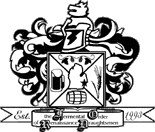
|

|

|

|

|

|
| April 2003 | Fermental Order of Renaissance Draughtsmen | Vol. 11 No. 4 |
The next meeting will be held back at Bailey's Pub 'N Grille in Dearborn on Tuesday, April 22, 2003. Bailey's is located on the southeast corner of Michigan and Mason. Their address is 22091 Michigan Avenue and their phone number is 313-277-3212. As usual, the thirsty hardcore who want dinner will start arriving around 5PM, people will drift in for an hour or so, and we will start our meeting around 6PM.
March's English & Scottish Strong Ale competition results are tabulated below.
| English & Scottish Strong Ale Competition | |||
|---|---|---|---|
| Place | Brewer | Style | Points |
| 1st | Bob and Kim Barrett |
Old Ale |
44/50 |
| 2nd | Bob and Kim Barrett |
Strong Scotch Ale |
40/50 |
| 3rd | |||
| HM | |||
This month's competition is Wines, Meads - BJCP Category 25, Ciders - BJCP Category 26. For the wine judging I found several interesting websites by doing a "Google" search:http://www.winesocietyoftexas.org/houston/FAQ_Wine_Judging.htm , http://www.longbeachgrandcru.com/judging.htm , http://www.faqs.org/faqs/drink/wine-faq/part4/index.html, and finally another wine faq meeting http://sbwines.com/usenet_winefaq/.
For Ciders and Meads there is always the BJCP guides.25. MEAD
25A. Traditional Mead
Aroma: Honey aroma should dominate, which may be sweet and may express the aroma of flower nectar. Aromas produced during fermentation, such as fruity esters and alcohol, may also be present.
Appearance: Clarity may be good to brilliant. Carbonated examples will show active evidence of dissolved gas but no head is expected. Color may range from pale straw to deep amber.
Flavor: The flavor of honey should be featured and may include residual sweetness. Any additives, such as acidity or tannin, should enhance the honey flavor and lend balance to the overall character of the mead.
Mouthfeel: Smooth texture. Most will be wine-like, with the warming presence of alcohol and sense of medium body. Sensations of a cloying or astringent character should be avoided.
Comments: A mead made primarily from honey, water and yeast. Meads which feature the character of a blended honey or a blend of honeys. For meads made from a single variety of money see below “B, Varietal Honey Traditional Mead.” While some oxidation of mead is OK and can actually lend useful complexity to the mead, over oxidation as exhibited by sherry-like aroma and/or taste should be avoided. Phenols produced by high temperature fermentation are also to be avoided. Entrants must specify whether the entry is still or sparkling mead. Entrants must also indicate whether the mead is dry, semi-sweet or sweet.
Vital Statistics: Effective OG: 1.070-1.120+
IBUs: N/A FG: 0.995-1.025
SRM: 1-16 ABV: 7.5-15+%
25B. Varietal Honey Traditional Mead
Aroma: Honey aroma should dominate, which may be sweet and may express the aroma of flower nectar. Aromas produced during fermentation, such as fruity esters and alcohol, may also be present. The particular Varietal honey aroma (such as orange blossoms for orange blossom honey) should be evident.
Appearance: Clarity may be good to brilliant. Carbonated examples will show active evidence of dissolved gas but no head is expected. Color may range from pale straw to deep amber.
Flavor: The flavor of honey should be featured and may include residual sweetness. The distinctive taste of the Varietal honey should be showcased. Any additives, such as acidity or tannin, should enhance the honey flavor and lend balance to the overall character of the mead.
Mouthfeel: Smooth texture. Most will be wine-like, with the warming presence of alcohol and sense of medium body. Sensations of a cloying or astringent character should be avoided.
Comments: Mead made from honey from a particular flower source. The brewer must name the varietal honey. Note that the character of a varietal honey will be identifiable as distinct to the source, but may not resemble the source. Orange-blossom honey has the character of orange blossoms, not oranges. Blackberry honey is only distantly like blackberries, although it is an identifiable character. While some oxidation of mead is OK and can actually lend useful complexity to the mead, over oxidation as exhibited by sherry-like aroma and/or taste should be avoided. Phenols produced by high temperature fermentation are also to be avoided. Entrants must specify whether the entry is still or sparkling mead. Entrants must also specify whether the entry is dry, semi-sweet or sweet.
Vital Statistics: Effective OG: 1.070-1.120+
IBUs: N/A FG: 0.995-1.025
SRM: 1-16 ABV: 7.5-15+
25C. Cyser (Apple Melomel)
A mead made with the addition of apples or apple juice. Traditionally, cysers are made by the addition of honey to apple juice without additional water.
Aroma: Should have distinct apple character with a pronounced honey aroma, which may be sweet and may express the aroma of flower nectar. Aromas produced during fermentation, such as fruity esters, low levels of sulfur and alcohol, may also be present.
Appearance: Clarity may be good to brilliant. Carbonated examples will show active evidence of dissolved gas but no head is expected. Color may range from pale straw to deep amber.
Flavor: Should have distinct apple character but should also have a balanced honey character. The Apple character may supply tart acidity to cut the honey sweetness, so one may notice tart acidity first and residual sweetness thereafter. Any additives, such as acidity or tannin, should enhance the honey flavor and lend balance to the overall character of the cyser. In well made examples of the style, the fruit is both distinctive and well-incorporated into the sugar-acid balance of the mead. Some of the best examples have the taste and aroma of an aged Calvados (apple brandy from northern France).
Mouthfeel: Smooth texture. Most will be wine-like, with the warming presence of alcohol and sense of medium body. Sensations of a cloying or astringent character should be avoided.
Comments: There should be an appealing blend of the fruit and honey character but not necessarily an even balance. Generally a good tannin-sweetness balance is desired, though very dry and very sweet examples do exist. Entrants must specify whether the entry is still or sparkling cyser. Entrants must also specify whether the entry is dry, semi-sweet or sweet.
Vital Statistics: Effective OG: 1.070-1.120+
IBUs: N/A FG: 0.995-1.025
SRM: 1-16 ABV: 7.5-15+%
25D. Pyment (Grape Melomel)
A mead made with the addition of grapes or grape juice. Alternatively, the pyment may be a grape wine sweetened with honey, a mixture of grape juice and honey that is fermented or a mixture of grape wine and mead mixed after fermentation.
Aroma: Should have distinct grape or grape-wine character with a pronounced honey aroma, which may be sweet and may express the aroma of flower nectar. Aromas produced during fermentation, such as fruity esters and alcohol, may also be present.
Appearance: Clarity will be good to brilliant. Carbonated examples will show active evidence of dissolved gas but no head is expected. Color would reflect the grape source, whether white, red or other.
Flavor: Should have distinct grape wine character, manifested in acidity, tannin and other grape characteristics, but the honey character should balance the fruit flavors. Grassy white wine character or buttery(diacetyl) Chardonnay character is appropriate in pyment only. In well made examples of the style, the fruit is both distinctive and well-incorporated into the sugar-acid balance of the pyment.
Mouthfeel: Smooth texture. Most will be wine-like, with the warming presence of alcohol and sense of medium body. Sensations of a cloying or astringent character should be avoided.
Comments: There should be an appealing blend of the fruit and honey character but not necessarily an even balance. Generally a good tannin-sweetness balance is desired, though very dry and very sweet examples do exist. Entrants must specify whether the entry is still or sparkling pyment. Entrants must also specify whether the entry is dry, semi-sweet, or sweet.
Vital Statistics: Effective OG: 1.070-1.120+
IBUs: N/A FG: 0.995-1.025
SRM: 1-16 ABV: 7.5-15+%
25E. Other Fruit Melomel
A mead made with the addition of other fruit or fruit juices. There should be an appealing blend of the fruit and honey character but not necessarily an even balance.
Aroma: Should exhibit the aroma of the fruit(s) present in the mead. In a melomel with a blend of fruits, one fruit may dominate the aroma profile.
Appearance: Clarity will be good to brilliant. Carbonated examples will show active evidence of dissolved gas but no head is expected. The particular fruit(s) used may or may not impart color to the mead.
Flavor: Fruit flavor contributions to the mead range from subtle acidic notes to intense, instantly recognizable fruit flavors. In a melomel with a blend of fruits, one fruit may dominate the flavor profile. There should be a balanced honey character as well. Some fruits will lend a cloying sweetness to the mead while others add a drying character. In well- made examples of the style, the fruit is both distinctive and well-incorporated into the sugar-acid balance of the mead.
Mouthfeel: Smooth texture. Most will be wine-like, with the warming presence of alcohol and sense of medium body. Sensations of a cloying or astringent character should be avoided.
Comments: Generally a good tannin-sweetness balance is desired, though very dry and very sweet examples do exist. Some fruits, notably darker ones like Blackberries, may contribute a tannin presence not unlike dark pyments. Some oxidative properties may be appropriate in certain fruit meads, giving them a sherry or port wine character. Entrants must specify whether the entry is still or sparkling mead. Entrants must also specify whether the mead is dry, semi-sweet or sweet.
Vital Statistics: Effective OG: 1.070-1.120+
IBUs: N/A FG: 0.995-1.025
SRM: 1-16 ABV: 7.5-15+%
25F. Metheglin
A mead made with the addition of spices or herbs.
Aroma: The spices/herbs may be expressed in the aroma. Honey characters should appear in the aroma but will vary in intensity depending on the spices/herbs used. Metheglins containing more than one spice should have a good balance among the different spices/herbs, though some spices/herbs will tend to dominate the aroma profile.
Appearance: Clarity may be good to brilliant. Carbonated examples will show active evidence of dissolved gas but no head is expected. Color may range from pale straw to deep amber; the color usually won't be affected by the spices or herbs.
Flavor: The spices/herbs should be expressed in the flavor but the honey character is still the backbone of the mead and should appear in the flavor but will vary in intensity depending on the spices/herbs used. The spices/herbs should be expressed in the flavor as a distinctive enhancement to the honey flavor, whether harmoniously or by contrast, and should achieve a pleasant balance when a blend of spices/herbs is used. Metheglins containing more than one spice should have a good balance among the different spices/herbs, though some spices/herbs will tend to dominate the flavor profile.
Mouthfeel: Smooth texture. Most will be wine-like, with the warming presence of alcohol and sense of medium body. Sensations of a cloying or astringent character should be avoided; however, some spices or herbs may affect mouthfeel particularly by adding astringency.
Comments: Often, a blend of spices may give a character greater than the sum of its parts. The better examples of this style use spices/herbs subtly and when more than one are used, they are carefully selected so that they blend harmoniously. Entrants must specify whether the entry is still or sparkling mead. Entrants must also specify whether the mead is dry, semi-sweet or sweet.
Vital Statistics: Effective OG: 1.070-1.120+
IBUs: N/A FG: 0.995-1.025
SRM: 1-16 ABV: 7.5-15+%
25G. Braggot
Meads made with both honey and malt providing flavor and fermentable extract. Originally, and alternatively, a mixture of mead and ale.
Aroma: Aroma of both honey and malt should be apparent and in balance. Hop aroma may be present but is not required.
Appearance: Straw to dark brown depending on the type of malt and honey used. Some head retention is expected. Clear, although some chill haze may be present at low temperatures.
Flavor: There should be some balance between the beer aspect and the mead aspect of a braggot, especially with regard to maltiness and bitterness versus honey character. Malt character ranges from light pale malt-type flavors to rich caramel flavors, depending on the malt used. Hop bitterness and flavor may be present but are not required.
Mouthfeel: Body may vary from light to medium. Smooth mouthfeel without astringency. Carbonation may vary from light to very lively.
Comments: The fermentable sugars should come from a balance of malt and honey, otherwise the beverage might better be entered as a Specialty Beer with the addition of honey. As a rule of thumb, the fermentables should consist of no less than 1/3 malt and no more than 2/3 honey. Hopped examples of this style should exhibit the hops distinctly and should have at least 15 IBUs.
Vital Statistics Effective OG: 1.060-1.120+
IBUs: 0-50 FG: 1.004-1.025
SRM: 3-16 ABV: 6.5-14%
25H. Mixed Category Mead
A mead that combines ingredients from two or more of the other mead sub-categories.
Aroma, appearance, flavor and other characteristics may vary and be combinations of the respective elements of the various sub-categories used in this style.
Comments: This mead should exhibit the character of all of the ingredients in varying degrees, and should show a good blending or balance between the various flavor elements.
26. CIDER
26A. Standard Cider and Perry
Aroma: Apples (pears, if a perry) should be distinctive and dominate. There may be some fermentation byproducts such as esters, alcohols and low levels of sulfur.
Appearance: Pale yellow to amber in color. Clear and brilliant. Carbonation may vary from absolutely still to very vigorous, as follows, Entrant must specify still or carbonated (level of carbonation optional):
Still: No carbonation visible or in the mouthfeel.
Petillant: Very lightly sparkling, visibly and in the mouth.
Sparkling: Clearly but not heavily carbonated.
Spuming or Spumante: Heavily and vigorously carbonated, bordering on gushing, with tight, fine bubbles, champagne-like.
Flavor: Crisp apple (pear) flavor should be present and distinctive. May be dry to sweet. Some noticeable alcohol character may be present at the upper end of the range (7%). There should be a balance in the acidic character and the residual sweetness.
Mouthfeel: Light body. No astringency. No carbonic bite from CO2.
Comments: Sugar adjuncts may be used. May be fermented by wine, Champagne, ale, lager or wild yeast. The entrant must also specify whether the entry is a cider or perry; dry, semi-dry or sweet; still or carbonated. If both apple and pear juice are used the entry must be entered as a special cider. Artificial carbonation is allowed. The method of carbonation need not be specified.
Vital Statistics: OG: 1.045-1.061
IBUs: NA FG: 0.990-1.012
SRM: 3-12 ABV: 4.5-7%
Commercial Examples: Broadoak, Hecks, Dunkerton's, Franklins, Rich's Framhouse Cider (all available only in England), Clos Normand, Herout Fils, Hornsby's Draft Cider (not the “Granny Smith” or “Amber”), Sidra El Gaitero, Kelly's Traditional Irish Premium Hard Cider, Minchew Perry (available only in England), Wyder's Pear Cider.
26B. New England-Style Cider
Aroma: Strong, pronounced apple aroma. The higher level of alcohol,8-14%, will be more noticeable in the aroma. Other fermentation byproducts may also be present.
Appearance: Pale to medium yellow. Still or sparkling. Carbonation must be natural. Clear and brilliant.
Flavor: Strong apple flavor. Usually dry. No hot alcohol taste. New England-Style cider is distinguished from other styles by its robust and sometimes unsophisticated taste. It is a rustic, homemade product, typically more forceful than delicate. Nevertheless, complexity and structure are often present.
Mouthfeel: Medium to full-bodied with some tannins.
Comments: Adjuncts may include white and brown sugars, molasses, honey (very sparingly), and/or raisins. Should use wild or wine yeast only. Entrants must specify whether still or sparkling and whether dry, semi-sweet or sweet.
Vital Statistics: OG: 1.061-1.105
IBUs: N/A FG: 0.990-1.010
SRM: 3-5 ABV: 7-14%
Commercial Examples: There are no known commercial examples of New England-style cider.
26C. Specialty Cider And Perry
Aroma: Apples (pears) should be distinctive and dominate. There may be some fermentation byproducts such as esters, alcohols and low levels of sulfur. Aromas from identified fruits and spices should also be noticeable as well.
Appearance: Carbonation may vary from absolutely still to very vigorous. Pale yellow in color, except where adjuncts such as spices or fruit may introduce a deeper shade or another color. Clear and brilliant.
Flavor: Crisp apple (pear) flavor should be present and distinctive. Declared adjuncts must be present in the taste and integrate well with the base cider. May be dry to sweet. Some noticeable alcohol character may be present but the emphasis should be on alcoholic warming, not the taste or harsh bite of alcohol in the mouth. There should be a balance in the acidic character and the residual sweetness.
Mouthfeel: Light to full body.
Comments: Sugar adjuncts may be used. May be fermented by wine, Champagne, ale, lager or wild yeast. There may be optional ingredients such as fruits and spices in which case the entrant must identify these. The entrant must also specify whether the entry is; dry, semi-dry or sweet; still or carbonated. Artificial carbonation is allowed. The method of carbonation need not be specified. The entrant must be careful in the use of honey as an adjunct; if the honey is the dominant fermentable the entry is a Cyser and must be entered in the Mead competition and not as a cider.
Ingredients: At least 75% apple (pear) juice with the remainder made from any variety of adjuncts. The alcohol content must be below 14%, but any type of yeast can be used in the production.
Vital Statistics: OG: 1.061-1.105
IBUs: N/A FG: 0.990-1.010
SRM: 3-12 ABV: 7-14%
Commercial Examples: Cider Jack fruit ciders.
Big brew 2003 is May 3 of this year. This year's beer recipes are Vagabond Gingered Ale and an Anchor Steam Beer clone. The recipes (both extract and all grain) and other information are at the AHA website.
Chris Frey is having his usual small intimate gathering. If you are in the area and plan on stopping by for the festivities, please contact Crispy by April 24 and tell him how many people are coming with you and what side dish you are bringing. Also, if you are planning to brew there and/or bringing a keg of homebrew to share let him know.
Chris has lined up two bands (blues & jazz) for this year and the music starts at 4:30. The toast is set for 5:30 p.m. I am sure Crispy will have a lot to say about this at the meeting.
http://www.infernalmachineshop.com/Keg_Rack_1.htm
Its how to modify a BMW motorcycle to carry two corney kegs!

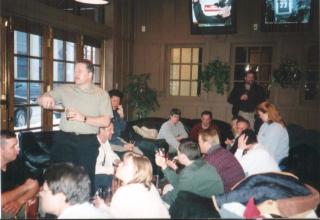
|
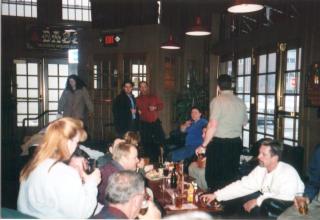
|

|
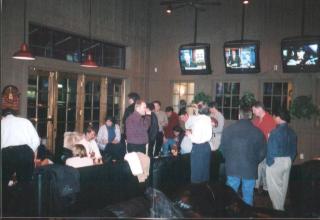 |
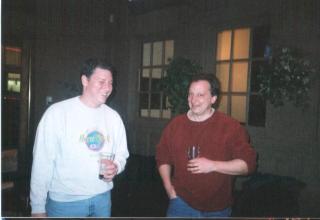 |
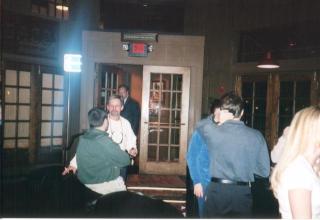 |
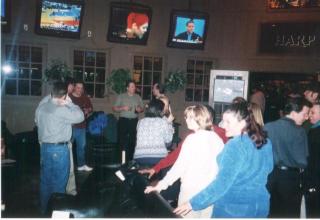 |
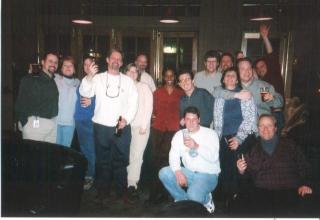 |
Next month's competition has three related categories, IPA - BJCP Category 7, APA - BJCP Category 6A, California Common - BJCP Category 6C
7. INDIA PALE ALE
Aroma: A prominent hop aroma of floral, grassy, or fruity characteristic typical. A caramel-like or toasty malt presence may also be noted, but may be at a low level. Fruitiness, either from esters or hops, may also be detected.
Appearance: Color ranges from medium gold to deep copper, with English versions often darker than American ones. Should be clear, although some haze at cold temperatures is acceptable.
Flavor: Hop flavor is medium to high, with an assertive hop bitterness. Malt flavor should be low to medium, but should be sufficient to support the hop aspect. Despite the substantial hop character typical of these beers, sufficient malt flavor, body and complexity to support the hops will provide the best balance. Very low levels of diacetyl are acceptable, and fruitiness from the fermentation or hops should add to the overall complexity. Some alcohol warming may be sensed in stronger versions.
Mouthfeel: Smooth, medium-bodied mouthfeel without astringency, although it has moderate carbonation combine to render an overall dry sensation in the presence of malt sweetness.
Overall Impression: A decidedly hoppy, moderately strong pale ale.
History: Brewed to survive the voyage from England to India. The temperature extremes and rolling of the seas resulted in a highly attenuated beer upon arrival.
Comments: A pale ale that was brewed to an increased gravity and hop rate.
Ingredients: Pale ale malt (well-modified and suitable for single-temperature infusion mashing); English hops were used in the original versions, but American hop varieties have found a place in many modern interpretations. Refined sugar may have been used in some versions also. High sulfate and low carbonate water is essential to achieving a pleasant hop bitterness.
Vital Statistics: OG: 1.050-1.075
IBUs: 40-60+ FG: 1.012- 1.016
SRM: 8-14 ABV: 5-7.8%
Commercial Examples: Anchor Liberty Ale, Sierra Nevada Celebration Ale, Brooklyn East India Pale Ale, Tupper's Hop Pocket, Great Lakes Commodore Perry IPA, Samuel Smith's India Ale, Fuller's IPA, Highfalls IPA, Victory Hopdevil, Three Floyds Alpha King.
6. AMERICAN PALE ALES
6A. American Pale Ale
Aroma: Usually moderate to strong hop aroma from dry hopping or late kettle additions of American hop varieties. Citrusy hop aroma very common. Esters vary from low to high. Diacetyl moderate to none.
Appearance: Pale golden to amber.
Flavor: Often moderate to high hop flavor. Citrusy hop flavor very common (such as from Cascades), but also other American hop variety flavors are found. Malt flavor moderate relative to aggressive hop flavor and bitterness. Balance towards bitterness. Caramel flavor is usually restrained. Diacetyl moderate to none.
Mouthfeel: Many are rather light, refreshing and more highly carbonated than many other styles, but body can reach medium. Carbonation borders on effervescent in some examples.
Overall Impression: Should be refreshing.
History: An American adaptation of English pale ale.
Comments: In the past, this category also covered what is now called American amber ale. American pale ales differ from American amber ales notably by being lighter in color, but also in having less caramel flavor and usually being balanced more towards hop bitterness.
Ingredients: Pale ale malt, typically American two-row. Light to medium crystal malts. American hops, often the citrusy ones such as Cascade, Centennial and Columbus, but others may also be used (e.g., Brewer's Gold or Willamette). Water can vary in sulfate content, but carbonate content should be relatively low.
Vital Statistics: OG: 1.045-1.056
IBUs: 20-40 FG: 1.010-1.015
SRM: 4-11 ABV: 4.5-5.7%
Commercial Examples: Sierra Nevada Pale Ale, Summit Pale Ale, Great Lakes Burning River Pale Ale.
Aroma: May have a pronounced woody or rustic hop aroma (as from Northern Brewer, for example). Restrained fruitiness. May have a moderate toasted malt aroma. Diacetyl low to none.
Appearance: Dark gold to copper to medium amber.
Flavor: Malty, balanced with a pronounced hop bitterness. Rustic/woody (e.g., Northern Brewer) hop flavor medium to none. May have a toasted (not roasted) malt flavor. Balance is generally about even between malt and hops. Diacetyl low to none.
Mouthfeel: Medium-bodied. Medium to medium-high carbonation.
Overall Impression: A beer with solid malt and hop expression, only mildly fruity and having woody/rustic hop character.
History: American West Coast original. Large shallow fermenters are used. Originally, in the absence of handy ice or refrigeration, the locally cool ambient temperatures of the San Francisco peninsula led to a beer that was fermented with lager yeast, but at temperatures that were at the cool end of the ale temperature range.
Comments: Similar to American pale ale, although typically less fruity. Hop flavor/aroma is woody rather than citrusy, although a slightly citrusy character has been noted by some in a commercial example back in the mid-1980s.
Ingredients: Pale ale malt, American hops (usually woody, such as Northern Brewer, rather than citrusy), small amounts of toasted malt and/or light caramel/crystal malts. Lager yeast, however some strains (often with the mention of "California" in he name) work better than others at the warmer fermentation temperatures (55 to 60oF) used (some German strains produce excessive sulfury character).Water should have relatively low sulfate and low to moderate carbonate levels.
Vital Statistics: OG: 1.044-1.055
IBUs: 35-45 FG: 1.011-1.014
SRM: 8-14 ABV: 4-5.5%
Commercial Examples: Anchor Steam, Old Dominion Victory Amber.
Here is the announcement for Big Brew '98
May 2nd is going to be a big day. In fact, it's going to be Big Brew '98/National Homebrew Day! Big Brew '98 is the record-setting attempt of the simultaneous brewing of many small homebrew batches of the same beer recipe by homebrewers across the nation. It is also to help celebrate the 10th anniversary of National Homebrew Day and the 20th anniversary of the American Homebrewers Association.
The recipe that we will be brewing, "Big 10/20", is based on Little Apple Brewing Company's "Big 12" Barley Wine, created and brewed by Rob Moline and winner of the Gold Medal in the Barley Wine category at the 1996 Great American Beer Festival.
We are spoken for as far as the club PICO is concerned. However, anyone who is interested should still plan to brew with us. You will need to bring your own equipment and supplies, although Merchants will provide the water for brewing & chilling. So, bottom line, if you want to brew, bring your pots, burners and materials and we will see you there! And you don't have to brew a barleywine if you don't want to. You're free to brew whatever you like. More details will be provided at the April meeting.
| Beer Events, Meetings & Competitions | 
|
| Fermental Funny |
The following Ogden Nash poem was contributed by Theresa Young
There is something about a Martini,
A tingle remarkably pleasant;
A yellow, a mellow Martini;
I wish I had one at present.
There is something about a Martini,
Ere the dining and dancing begin,
And to tell you the truth,
It's not the vermouth -
I think that perhaps it's the gin.
-by Ogden Nash (Poet) who also coined the phrase: "Candy is dandy but liquor is quicker" in his poem "Reflections on Ice Breaking."
| Ye Olde Brew News
published by the F.O.R.D. Homebrew Club |
|
| Editor: Tony Tantillo Contributors: Club Officers: |
F.O.R.D. is a private, non-profit organization of homebrewers.
The main goal of this club is to promote awareness and appreciation of the
quality and variety of beer; to share information regarding technique, equipment
and skill required to brew quality homemade beer; and to encourage responsible
use of beer as an alcohol-containing beverage. Howard Klix Jr. 24737 Cushing Ave Eastpointe, MI 48021 Phone: (586) 779-1445 Visit our website at: http://www.be.ford.com/brewers/
current circulation... 125 |